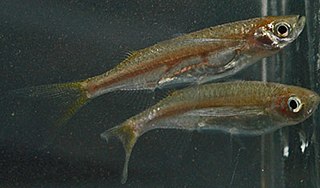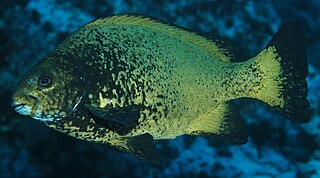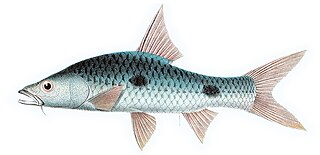
Parachela is a genus of freshwater ray-finned fish belonging to the family Xenocyprididae, the East Asian minnows or sharpbellies. These fishes are found in Asia.

The sea chubs, also known as rudderfish and pilot fish and in Hawaiian as enenue or nenue, are a family, Kyphosidae, of fishes in the order Perciformes native to the Atlantic, Indian and Pacific Oceans usually close to shore in marine waters.

Chanodichthys is a genus of freshwater ray-finned fishes belonging to the family Xenocyprididae, the East Asian minnows or sharpbellies. The species in this genus are found in Eastern Asia. The name is derived from the Greek word chanos, meaning "abyss, mouth opened, inmensity", and the Greek word ichthys, meaning "fish". Chanodichthys is closely related to Culter and some species have been moved between these genera.

Hampala is a genus of freshwater ray-finned fish belonging to the family Cyprinidae, the family which includes the carps, barbs and related fishes. The fishies in this genus are found in South-East Asia.
The white Amur bream is a species of freshwater ray-finned fish belonging to the family Xenocyprididae, the East Asian minnows or sharpbellies This is the only species in the monospecific genus Parabramis. It is native to eastern Asia, where found from the Amur River basin in Russia south to Ningbo and Shanghai in China. It is an important food fish, and has been introduced to regions outside its native range.

Lobocheilos is a genus of fish in the family Cyprinidae native to Asia.

Cyclocheilichthys is a genus of ray-finned fish in the family Cyprinidae containing approximately nine valid species. They are native to freshwater habitats in Southeast Asia and China.

Puntioplites is a genus of freshwater ray-finned fish belonging to the family Cyprinidae, the family which includes the carps, barbs, minnows and related fishes. The fishes in this genus are found in eastern Asia.

Moringua is a genus of eels of marine ray-finned fishes belonging to the family Moringuidae, the spaghetti eels. These eels occur in shallow tropical and subtropical waters.
Congresox is a genus of marine ray-finned fishes belonging to the family Muraenesocidae, the pike congers. The fishes in this genus are found in the Indian and Pacific Oceans.

Bangana is a genus of fish in the family Cyprinidae, the carps and minnows. It is distributed across much of southern and eastern Asia. Species live mainly in the flowing waters of tropical and subtropical rivers.

Diplocheilichthys is a genus of freshwater ray-finned fish belonging to the family Cyprinidae, the carps, barbs, minnows and related fishes. The two species which belong to this genus are found in East Malaysia and Indonesia.

Osteochilus is a genus of freshwater ray-finned fish belonging to the family Cyprinidae, the family which includes the carps, barbs, minnows and related fishes. The fishes in this genus are mainly found in Southeast Asia with a few extending into adjacent parts of China.
Paralaubuca s a genus of freshwater ray-finned fish belonging to the family Xenocyprididae, the East Asian minnows or sharpbellies. The species in this genus are found in Asia.
Pseudobrama is a monospecific genus of freshwater ray-finned fish belonging to the family Xenocyprididae, the East Asian minnows or sharpbellies. The only species in the genus is Pseudobrama simoni, a fish endemic to China. This species is found in fresh and brackish water in the Yangtze and other rivers in Eastern China.

Schismatorhynchos is a genus of freshwater ray-finned fishes eblonging to the family Cyprinidae, the family which includes the carps, barbs, minnows and related fishes. The fishes in this genus are found on Sumatra and Borneo in Indonesia and East Malaysia.

Thynnichthys is a genus of freshwater ray-finned fish belonging to the family Cyprinidae, the family which also includes the carps, barbs, minnows and related fishes. The fishes in this genus are found in southern Asia from India to Borneo.
Xenocypris is a genus of freshwater ray-finned fish belonging to the family Xenocyprididae, the East Asian minnows or sharpbellies. In addition to the extant species, X. yushensis, being known only from fossils, and one, X. yunnanensis, which is critically endangered or recently extinct.

Cyclocheilos is a genus of freshwater ray-finned fishes belonging to the family Cyprinidae, the family which includes the carps, barbs and related fishes. This fishes in this genus are found in Southeast Asia.
Chedrinae, the troutbarbs, is a subfamily of freshwater ray-finned fishes belonging to the family Danionidae, the danionins or danios. The fishes in thus subfamily are found in Asia and Africa.















